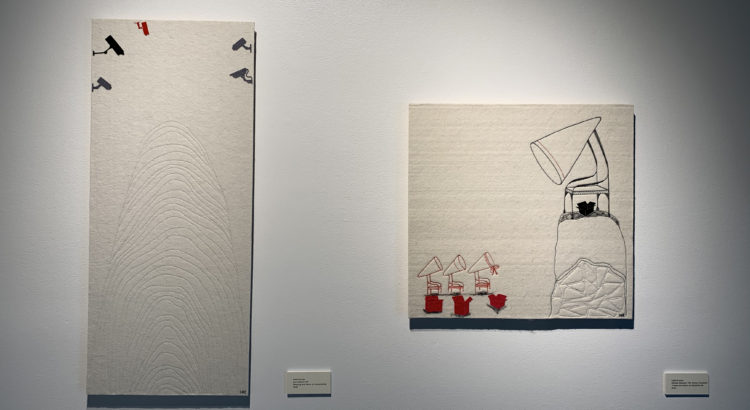Professor Heidi Kumao’s solo exhibition features fabric works and experimental animations that capture ordinary conversations and relationships. What sets Professor Kumao’s work apart from other artwork exploring a similar concept is not only the unique medium, but also the fact her work is told from a feminist perspective. She explores underlying emotions and tensions in everyday interactions by representing trauma and power imbalance. The title, Real and Imagined, reflects public support for and backlash towards women who have spoken up about assault, harassment, and misconduct. A woman’s experience can be believed to be an honest account but dismissed as wrongly remembered or entirely made up.
Professor Kumao’s work is minimalistic, but her work is far from lacking meaning or appearing overly simplistic and therefore unclear. Her work is almost playful or childlike – the style is reminiscent of something you’d see in a picture book. However, the seemingly innocent appearance of Professor Kumao’s artwork is sharply contrasted by how effectively she is able to convey emotion in her work.
For example, in the above piece titled “Consultation,” we see what is unmistakably a gynecologist’s office, with the door, chair, and the exam chair with stirrups. Although there are only really three focal points in the piece, with the background being all white, Professor Kumao was able to clearly set the scene, as well as create an atmosphere of unease with the vivid red. Red, as we all know, is often associated with danger or a warning, but Professor Kumao deliberately created a sense of discomfort rather than immediate danger. The scene can be interpreted as simply unsettling, but also preceding or directly following the suggested danger.
The jumble of thread sitting on the chair appears multiple times throughout the exhibition, including in the below piece titled “Reluctant Narrator.” In this piece, the thread is being pulled at, hinting at the unraveling of a narrative. She once again uses red, but the thread is in more disarray than the thread in “Consultation.” This seems to directly reference the “Reluctant” part of the title, again creating a sense of unease. On the other hand, in “Consultation,” the thread is still entirely intact, suggesting that perhaps there is something that happened around the time of the scene depicted.
Obviously, these are just my interpretations of some of Professor Kumao’s work, but I find it so impressive how effective her work is. There is always some blank space in each piece, but rather than leaving each piece seemingly unfinished, she is able to tell a story without overcrowding the felt canvas. Furthermore, I can only imagine how long it took to create this exhibition. The felt cutouts have a sense of depth, and you can always tell which way a chair or spotlight is facing. Her shapes are very distinct and it’s clear why she chose to include them – office chairs to represent power imbalances and spotlights to represent public scrutiny.
Overall, Professor Kumao’s exhibition is very strong and very impactful. It leaves room for interpretation, but it isn’t needlessly confusing. It’s clear that she put in a lot of time and care into this project, and I would encourage you to see it in person.
Real and Imagined is currently on display at the Stamps Gallery, which is open on Tuesdays and Fridays to visitors with an M-Card and a mask.




